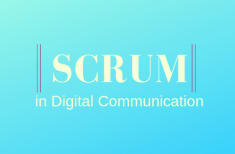

In a constantly changing and highly competitive corporate environment, communication projects require careful management and agility to meet their goals.
To succeed at this challenge, communication teams need to be flexible, focused and innovative.
My background is in communication and project management and I am interested in how these two fields complement each other.
I will look at how using scrum, a proven and efficient management framework used in projects primarily by software developers and based on Agile Methodology, can benefit communication teams.
Traditional project management starts with research and analysis, then strategy, smart goals, a detailed action plan, and finally an evaluation of results. The entire project is planned in advance without any scope for variation. There are a number of weaknesses in this method that teams encounter.
For example:
1) These models require a clear scope and time plan. Unforeseen changes and other variables, however, can cause major project delays.
2) While the project manager is generally informed about everything, often the project’s objective and progress are not adequately communicated to all stakeholders.
3) Traditional project methods require finishing a task before starting another one and, depending on the size of the project, this can cause major timeline issues.
4) Not all team members receive the same updates about the project. For example, those working part-time lack up-to-date information about progress compared to others who may be working full-time on the project.
5) Sometimes teams will use their own preferred means of communicating (such as email, phone, or short meetings) to produce a report. This exchanged information does not always reflect what is important for other teams in the project. In addition, if members of a team each have their own communication channels, and there is no methodical way to record information, uncertainty can occur. As a result, when people don’t have the information they feel they need, low productivity puts the project at risk.
Importantly, what is lacking in traditional project management is the ability for communication teams to use a common communication channel. To fix this, teams need to use communication technology that is reliable and easy to use; a transparent system with a dashboard so teams can see the progress of all the team’s work.
In early 1990s Jeff Sutherland, a fighter pilot, and Ken Schwaber, a software developer, worked together on an idea.
After working with traditional project management methodologies in the IT field, it was clear that there were many shortcomings in the system.
Projects were late and managers were not able to resolve problems, much less find the source. When this happened, everybody just blamed each other and communication broke down.
Sutherland and Schwaber decided to create a simple concept based on Agile methodology to provide an enhanced overview of a project’s progress and allow flexibility. They called it ‘scrum.’
Scrum is a framework for managing a process.
The essence of scrum is having a small team of people or cross-functional teams with a high-level of autonomy. This autonomy means that each team is held accountable for their work and has responsibility to fix any problems that could arise. The idea is for team members to work together to solve issues and take responsibility for implementing ideas
In “The Scrum Guide”, a book published in 2010, Sutherland says that Scrum only works if you have certain values in place. These are:
Teaching employees the key aspects of scrum, and addressing their concerns by customising the framework to their needs, results in greater satisfaction from team members and greater improvements in project quality.
Many organisations now use scrum in fields as diverse as healthcare, education, and manufacturing. The latest results from the main Scrum website record more than 12 million daily users globally.
According to the Project Management Institute (PMI), almost three-quarters (71 percent) of their members use Agile methodology for project work, but only recently has scrum found its way into the digital, communication, and marketing world.
Here we present a case study about implementing scrum into the editorial department of a Swiss company where creativity, productivity and planning are paramount.

Geneva Business News was founded as a news platform covering local and international events. The company places emphasis on teamwork, a flat hierarchy and little bureaucracy.
Working in this culture and having the support to innovate provided a good environment to establish a scrum-based project.
There are about 30 to 40 people contributing to the editorial department and managers needed a new method for following up on the progress of each contributor. There was no clear schedule for publication nor transparent communication between staff and managers. Reviewers and editors found it hard to plan the workload, and more importantly, there was no global overview of progress.
The necessity for agility, flexibility, and team connection was needed and everything was calling out for SCRUM!
When the need for change was discussed with the team it was initially poorly received. For some team members, the barriers to entry for using scrum, or any new project management framework, can be high. A glossary of technical terms can be confusing, and some were reluctant to show their work progress in real-time.
For this reason, someone with an understanding and experience of scrum and communication projects needed to take responsibility for the transition, overseeing and managing it for everyone’s benefit.
The first stage was to assign roles and responsibilities.
In Scrum there are three roles:
Those three working together are called the Scrum Team. At GBN, the responsibilities for each role were as outlined below:
1- Product owner – clearly communicating the benefits of using this framework and the reason for change. Importantly, this role involves convincing team members to trust you and follow you. This can be done, for example, by organising workshops in advance, talking to team members to understand their expectations, and tailoring the tool depending on the team’s needs.
2- Product Owner - Setting SMART goals and prioritising them.
3- Product Owner - Breaking down tasks until even the smallest jobs are covered. These can be milestones, deliverables, user stories, or simply conceiving ideas.
4- Scrum Master - Creating a task board to visualize workflow and prioritizing work. The easiest way is to use an available platform on the Internet such as Taiga, which allows you to check progress by simply glancing at the appropriate table.
5- The team members - acting collectively and deciding how to achieve the set goals.
6- Scrum Master - Testing, receiving feedback, and updating progress as appropriate to drive continuous improvement.
Scrum accelerated the time to deliver a project at GBN, supported greater innovation, boosted customer experience and improved product quality.
Once the basics of scrum were well communicated to the team, we found we could employ the framework in the digital communication and marketing teams, including projects in editorial, content clearance, public relations, media, audience engagement, marketing campaigns, product launch, and event promotion.
The video “SCRUM and education WORK“ from the Communication, Media & IT school of Hanze University Groningen provides another good example of the innovative ways to teach scrum to communication and media students to help them finish their final project.
SCRUM and education WORK from belevinginbeeld on Vimeo.
A clear vision for the change and the right training will create a new mindset.
Transitioning to a new project methodology requires information on the benefits of change. In addition, people involved in the project want certainty and a clear understanding of the goals.
Teaching employees the key aspects of scrum, and addressing their concerns by customising the framework to their needs, results in greater satisfaction from team members and greater improvements in project quality.
Sources :
Photo credit :
Video credit :